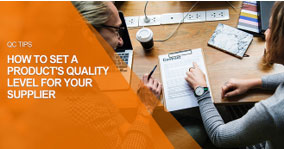In a previous article, we’ve shared some tips on how to choose good inspection companies in China.
After selecting a good QC partner, how to make sure that the inspection company you’ve chosen will fully understand your product and your QC criteria? What information do buyers need to send to the inspection companies?
We’ve met with a case before that the quality of the inspected goods was in fact excellent. However, the factory used Polypropylene plastic (PP) instead of rubber for one specific part of the product. The inspector on the ground only had pictures of the product for comparison purposes, and the customer hadn’t specified the material in advance. Without this information notified prior to the inspection, inspectors wouldn’t be able to find out that there is inconformity. If this information were provided in advance, the report would have been different and this customer would have avoided the headache of opening his 40HQ container only to find out that the handle of his screwdrivers is plastic, not rubber.
Many inspection companies will claim that they have plenty of experience in inspecting all types of products, however, the truth is, researching, developing as well as implementing QC checklists for all types of products take a while and only companies that have been around for years can provide very specific checklists for all kinds of product. Experienced companies have very comprehensive protocols which are normally available in their on-line booking systems and buyers can have access to them before each inspection to confirm whether the checking criteria available for their product conforms to their own criteria.
In order to make full use of the inspection service, it is suggested that the buyers provide more files to check and verify during the inspection as the more details buyers send to the inspection company, the more effective the inspection will be. Spending time to draft a plan will help to diminish future quality problems down the road such as,
- Logos in different sizes, colors, and shapes
- Different materials/packaging/components
- Misspelled labels, shipping marks, user manuals, and much more.
Here are the additional files that can be useful to be the inspections’ reference,
- Approval samples or sealed samples at the factory (Highly recommended)
- Detailed pictures of the product (internal and external)
- Product specifications including material list and sizes.
- Logos, artwork, drawings, shipping marks, labels, and packaging.
- Purchase order (removing the confidential information)
- Tech-pack for garments
- User manual
- CDF for electrical or electronic products
- Other special requirements or information concerning quality problems found in previous shipments
Recommended:
 |
How to Set a Product’s Quality Level for Your Supplier Did you ever have difficulty in explaining your product requirements to supplier? Setting up a quality level for your production is not always easy. Read more |
V-Trust has a solid history in helping overseas importers ensure their products will be shipped in accordance with their quality standards and in compliance with markets’ regulations. Our customer service team will walk you through step-by-step helping you set your quality protocols for your suppliers in Asia.
For more information concerning quality control, please feel free to contact us at info@v-trust.com




内容